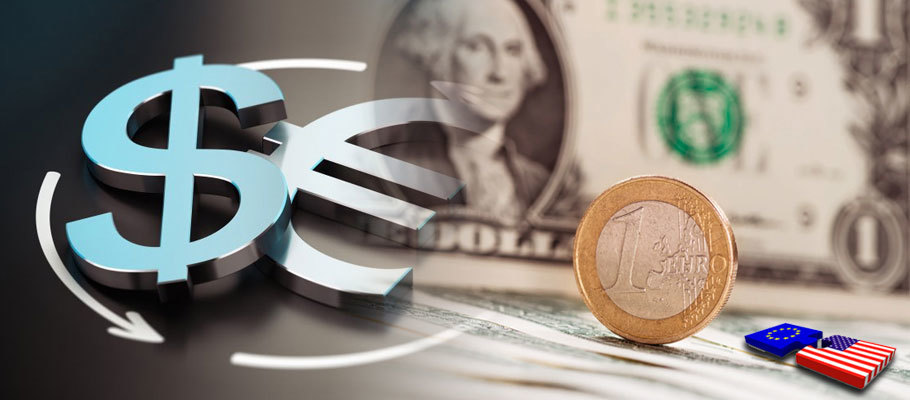
Published: February 2nd, 2022
The euro to dollar (EUR/USD) rate could be set to rise through February as a growing chorus of forex strategists say the greenback will face headwinds as markets sense the European Central Bank (ECB) is preparing to bring forward its first interest rate hike, even as US rate expectations recede.
EUR got a lift on Monday 31st January as markets looked favourably on developments in Italy, where neoliberal technocrat Mario Draghi looked set to carry on as Prime Minister.
After the re-election of President Sergio Mattarella, market watchers believe the election result will bring policy continuity and stability and give Draghi the freedom to push ahead with EU-mandated policy changes needed to receive more than EUR 200 billion in funding from Brussels.
In a note to investors, HSBC’s US FX Strategy Unit said the re-election of Mattarella was good news for markets. 'It means Mario Draghi will stay in place as Prime Minister, probably until national elections are held again in 2023.’
A euro rally off the back of the news means the exchange rate for EUR/USD has risen from last week’s (week commencing 24th January) multi-month low.
Chart trends still appear to favour the greenback in the short term. However, a lot will depend on what comes out of the European Central Bank (ECB) policy meeting on Thursday, 3rd February.
No major departures from current policy are expected, though forex traders will be keen to hear the central bank's latest comments on inflation.
Traders are likely looking for the ECB to raise rates at the end of 2022. Much of the euro outlook could depend on whether central bankers in Frankfurt meet that expectation.
A market analysis by Reuters found that falling Euribor prices suggested that investors are shifting expectations for an ECB rate hike forward, with December 2022 the likely timing. Speculation about a September rate rise is also growing.
German ten-year yields have reached a 30-month high of 0.028 per cent, Reuters says, in response to those expectations.
For now, Frankfurt is likely to keep its mega-dovish reputation and say that inflation will diminish again this year and that the risk of inflation staying stuck above their two per cent target is minimal.
But even if the ECB sticks to its 2021 script, the EUR-USD exchange rate could keep rising.
That's because the dollar began February on the back foot, watering down the strong buying interest that followed the Fed's January policy update. That would likely give EUR/USD upside momentum.
Reuters said EUR/USD looks to have got through the initial storm following last week's meeting of Fed policymakers. And another analyst believes the dollar could be vulnerable in February.
Brina Dunleavy of Barclays Currency Strategy Unit told Bloomberg that conditions point to a great place for traders to consider short dollars. Numerous signs suggest it's an excellent tactical entry.'
Dunleavy also said that the January month-end session was dominated by notable dollar buying. In February, the market might now be ready to sell greenbacks.
He added that forex markets have a tendency to revert on trends seen in January, suggesting USD strength will probably unwind.
Last month (January 2022), USD appreciated by about one per cent against sterling and close to two per cent against the euro.
Despite potential dollar headwinds, it won't be all smooth sailing for euro bulls. At mid-week (2nd February), the EUR/USD rate recovered the 1.13 handle set on Monday. However, significant technical resistances and the impending European Central Bank (ECB) monetary policy meeting still threatened to put the single currency on ice.
At the time of writing, the euro was on course for a triplet of gains over the greenback as it continued its bid to win back the losses suffered after last Wednesday's (26th January) US Federal Reserve monetary policy meeting.
EUR/USD sunk to an 18-month low following Fed Chairman Jerome Powell’s suggestion that American interest rates could come up in April and could lift further and faster than the market consensus. The key variable will be if inflation continues its current trajectory.
However, as dollar enthusiasm cools, the euro-dollar rate appeared set to attempt a further recovery by week's end.
'Breaking above 1.13 is the indicator we’re watching for as the trigger for a possible reversal in the single currency’s recent losses,” warned FX strategists at Scotiabank in a research note.
'Forex traders will be encouraged by a five per cent figure for German inflation and continue to bet on further ECB rate hikes in 2022. It's our view, however, that this is very unlikely. Frankfurt will re-affirm its long-held view that Eurozone inflation will fall back below the two per cent target and set policy and timings around interest rates accordingly'.
While rates for American dollars eased widely as this week's session began, a shift that explains much of the jump in EUR/USD, the early inflation data from Germany released on Tuesday could also have jolted interest in the euro. The content of German economic statistics and their release so close to this Thursday's European Central Bank policy committee meeting will undoubtedly be influential.
Figures from Berlin show inflation in the Eurozone's leading economy edging lower from 5.2 per cent to 4.8 per cent, but still near the highest level seen since the early 1990s. This is despite pandemic-skewed base effects that had artificially inflated last year’s (2021) statistics.
In an interview with Deutsche Welle, ECB chief economist Phillip Lane said markets and policymakers needed to look at the three years of the pandemic as ‘part of a pandemic cycle’.
'In year one, inflation was relatively low. By the second half of year two, inflation spiked upward. Now, as we look ahead into the remainder of year three, we believe that inflation will stay high in the first quarter then start to drop, most notably at the end of the year'.